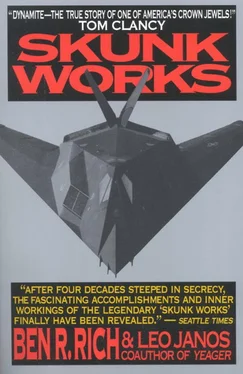Denys was a hearty outdoorsman, a cross-country ski addict and avid mountain biker, a terrific fellow generally, but inexplicably fascinated by radomes and radar. That was his specialty, designing radomes—the jet’s nose cone made out of noninterfering composites, housing its radar tracking system. It was an obscure, arcane specialty, and Denys was the best there was. He loved solving radar problems the way that some people love crossword puzzles.
“Boss,” he said, handing me the diamond-shaped sketch, “Meet the Hopeless Diamond.”
“How good are your radar-cross-section numbers on this one?” I asked.
“Pretty good.” Denys grinned impishly. “Ask me, ‘How good?’ ”
I asked him and he told me. “This shape is one thousand times less visible than the least visible shape previously produced at the Skunk Works.”
“Whoa!” I exclaimed. “Are you telling me that this shape is a thousand times less visible than the D-21 drone?”
“You’ve got it!” Denys exclaimed.
“If we made this shape into a full-size tactical fighter, what would be its equivalent radar signature… as big as what—a Piper Cub, a T-38 trainer… what?”
Denys shook his head vigorously. “Ben, understand, we are talking about a major, major , big-time revolution here. We are talking infinitesimal .”
“Well,” I persisted, “what does that mean? On a radar screen it would appear as a… what? As big as a condor, an eagle, an owl, a what?”
“Ben,” he replied with a loud guffaw, “try as big as an eagle’s eyeball .”
2
ENGINES BY GE, BODY BY HOUDINI
KELLY JOHNSON was not impressed. He took one look at Dick Scherrer’s sketch of the Hopeless Diamond and charged into my office. Unfortunately, he caught me leaning over a work table studying a blueprint, and I never heard him coming. Kelly kicked me in the butt—hard too. Then he crumpled up the stealth proposal and threw it at my feet. “Ben Rich, you dumb shit,” he stormed, “have you lost your goddam mind? This crap will never get off the ground.”
Frankly, I had the feeling that there were a lot of old-timers around the Skunk Works who wanted badly to do what Kelly had just done. Instead they did it verbally and behind my back. These were some of our most senior aerodynamicists, thermodynamicists, propulsion specialists, stress and structures and weight engineers, who had been building airplanes from the time I was in college. They had at least twenty airplanes under their belts and were walking aviation encyclopedias and living parts catalogs. Over the years they had solved every conceivable problem in their specialty areas and damned well knew what worked and what didn’t. They were crusty and stiff-necked at times, but they were all dedicated, can-do guys who worked fourteen-hour days seven days a week for months on end to make a deadline. Self-assurance came from experiencing many more victories than defeats. At the Skunk Works we designed practical, used off-the-shelf parts whenever possible, and did things right the first time. My wing man, for example, had designed twenty-seven wings on previous Skunk Works’ airplanes before tackling the Hopeless Diamond. All of us had been trained by Kelly Johnson and believed fanatically in his insistence that an airplane that looked beautiful would fly the same way. No one would dare to claim that the Hopeless Diamond would be a beautiful airplane. As a flying machine it looked alien .
Dave Robertson, one of Kelly’s original recruits and aerospace’s most intuitively smart hydraulic specialist, ridiculed our design by calling it “a flying engagement ring.” Dave seldom minced words; he kept a fourteen-inch blowgun he had fashioned out of a jet’s tailpipe on his desk and would fire clay pellets at the necks of any other designers in the big drafting room who got on his nerves. Robertson hated having anyone look over his shoulder at his drawing and reacted by grabbing a culprit’s tie and cutting it off with scissors. Another opponent was Ed Martin, who thought that anyone who hadn’t been building airplanes since the propeller-driven days wasn’t worth talking to, much less listening to. He called the Hopeless Diamond “Rich’s Folly.” Some said that Ed’s bark was worse than his bite, but those were guys who didn’t know him.
Most of our veterans used slide rules that were older than Denys Overholser, and they wondered why in hell this young whippersnapper was suddenly perched on a throne as my guru, seemingly calling the shots on the first major project under my new and untested administration. I tried to explain that stealth technology was in an embryonic state and barely understood until Denys unearthed the Ufimtsev theory for us; they remained unconvinced even when I reminded them that until Denys had come along with his revelation, we had known only two possibilities to reduce an airplane’s radar detection. One way was to coat the fuselage, tail, and wing surfaces with special composite materials that would absorb incoming electromagnetic energy from radar waves instead of bouncing it back to the sender. The other method was to construct an airplane out of transparent materials so that the radar signals would pass through it. We tried an experimental transparent airplane back in the early 1960s and to our dismay discovered that the engine loomed ten times bigger on radar than the airplane because there was no way to hide it.
So all of us, myself especially, had to trust that Denys Overholser, with his boyish grin and quiet self-confidence, really knew what in hell he was talking about and could produce big-time results. Dick Cantrell, head of our aerodynamics group, suggested burning Denys at the stake as a heretic and then going on to conventional projects. Cantrell, normally as soft-spoken and calm as Gregory Peck, whom he vaguely resembled, nevertheless had the temperament of a fiery Savonarola when, as in this instance, basics of fundamental aerodynamics were tossed aside in deference to a new technology understood only by witches and mathematical gnomes. But after a couple of hours of listening to Overholser’s explanations of stealth, Dick dropped his lanky frame onto the chair across from my desk and heaved a big sigh. “Okay, Ben,” he muttered, “I surrender. If that flat plate concept is really as revolutionary as that kid claims in terms of radar cross section, I don’t care what in hell it looks like, I’ll get that ugly son-of-a-bitch to fly.”
We could get the Statue of Liberty to do barrel rolls with the onboard computers that achieved aerodynamic capability by executing thousands of tiny electrohydraulic adjustments every second to an airplane’s control surfaces. This computerized enhanced flight stability gave us latitude in designing small, stealthy wings and short tails and mini-wing flaps, and left the awesome problems of unstable pitch and yaw to the computers to straighten out. Without those onboard computers, which the pilots called “fly-by-wire,” since electric wiring now replaced conventional mechanical control rods, our diamond would have been hopeless indeed. But even with the powerful onboard computers, getting into the sky, as Kelly’s boot to my butt suggested, would be far from a cakewalk.
We had a very strong and innovative design organization of about a dozen truly brilliant engineers, working at their drawing boards in a big barnlike room on the second floor of our headquarters building, who simply could not be conned or browbeaten into doing anything they knew would not work. One day, Kelly called upstairs for an engineer named Bob Allen. “Bob Allen there?” he asked. Whoever answered the phone replied, “Yeah, he is.” And hung up. Kelly was livid, but deep down he appreciated the feisty independence of his best people. The designers were either structural specialists who planned the airframe or systems designers who detailed the fuel, hydraulics, electrical, avionics, and weapons systems. In many ways they comprised the heart and soul of the Skunk Works and also were the most challenged by the structural demands of the new stealth technology. Thanks to Ufimtsev’s breakthrough formula, they were being told to shape an airplane entirely with flat surfaces and then tilt the individual panels so that radar energy scattered away and not back to the source. The airplane would be so deficient in lift-drag ratio that it would probably need a computer the size of Delaware to get it stable and keep it flying.
Читать дальше












